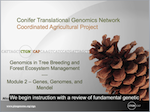Authors:
Nicholas Wheeler, Oregon State University; David Harry, Oregon State University; Heather L. Merk, The Ohio State University
Introduction
Development of association genetics, sometimes called association mapping or LD mapping, was driven by human geneticists seeking to characterize the hereditary basis of disease. The approach was made possible by the discovery of literally millions of SNPs in the human genome and the development of high throughput platforms that provide genotypes simultaneously for hundreds of thousands of SNPs. The approach was rapidly adopted by plant and animal breeders who envisioned its application for marker-assisted selection (MAS). The forest genetics community initiated association studies in 2000 and has contributed significantly to the development of high throughput genotyping capacity for the plant community.
Module 11 — Association Genetics
See other Conifer Genomics Modules
You can also watch the video on YouTube.
References Cited
- Bradbury, P. J., Z. Zhang, D. E. Kroon, T. M. Casstevens, Y. Ramdos, and E. S. Buckler. 2007. TASSEL: Software for association mapping of complex traits in diverse samples. Bioinformatics 23: 2633-2635. (Available online at: http://dx.doi.org/10.1093/bioinformatics/btm308) (verified 2 June 2011).
- Flint-Garcia, S. A., A. C. Thuillet, J. M. Yu, G. Pressoir, S. M. Romero, S. E. Mitchell, J. Doebley, S. Kresovich, M. M. Goodman, and E. S. Buckler. 2005. Maize association population: A high-resolution platform for quantitative trait locus dissection. Plant Journal 44: 1054-1064. (Available online at: http://dx.doi.org/10.1111/j.1365-313X.2005.02591.x) (verified 2 June 2011).
- Jorgenson, E. and J. Witte. 2006. A gene-centric approach to genome-wide association studies. Nature Reviews Genetics 7: 885-891. (Available online at: http://dx.doi.org/10.1038/nrg1962) (verified 2 June 2011).
- Marchini, J., L. R. Cardon, M. S. Phillips, and P. Donnelly. 2004. The effects of human population structure on large genetic association studies. Nature Genetics 36: 512-517. (Available online at: http://dx.doi.org/10.1038/ng1337) (verified 2 June 2011).
- McCarthy, M. I., G. R. Abecasis, L. R. Cardon, D. B. Goldstein, J. Little, J.P.A. Iaonnidis, and J. N. Hirschhorn. 2008. Genome-wide association studies for complex traits: consensus, uncertainty and challenges. Nature Reviews Genetics 9: 356-369. (Available online at: http://dx.doi.org/10.1038/nrg2344) (verified 2 June 2011).
- Neale, D. B., and O. Savolainen. 2004. Association genetics of complex traits in conifers. Trends in Plant Science 9: 325-330. (Available online at: http://dx.doi.org/10.1016/j.tplants.2004.05.006) (verified 2 June 2011).
- Pearson, T. A., and T. A. Manolio. 2008. How to interpret a genome-wide association study. Journal of the American Medical Association 299: 1335-1344. (Available online at: http://dx.doi.org/10.1001/jama.299.11.1335) (verified 2 June 2011).
- Rafalski, A. 2002. Applications of single nucleotide polymorphisms in crop genetics. Current Opinion in Plant Biology 5: 94-100.
- Wheeler, N. C., K. D. Jermstad, K. Krutovsky, S. N. Aitken, G. T. Howe, J. Krakowski, and D. B. Neale. 2005. Mapping of quantitative trait loci controlling adaptive traits in coastal Doublas-fir. IV. Cold-hardiness QTL verification and candidate gene mapping. Molecular Breeding 15: 145-156. (Available online at: http://dx.doi.org/10.1007/s11032-004-3978-9) (verified 2 June 2011).
- Yu, J., G. Pressoir, W. H. Briggs, I. V. Bi, M. Yamasaki, J. F. Doebley, M. D. McMullen, et al. 2006. A unified mixed-model method for association mapping that accounts for multiple levels of relatedness. Nature Genetics 38: 203-208. (Available online at: http://dx.doi.org/10.1038/ng1702) (verified 22 March 2012).
Cite This Learning Module
- Wheeler, N., and D. Harry. Association genetics [Online]. Genomics in Tree Breeding and Forest Ecosystem Management, Conifer Translational Genomics Network. eXtension Foundation. Available at: https://plant-breeding-genomics.extension.org/association-genetics:-conifer-genomics-module-11/ (verified April 22, 2013).
Author Contributions
- Nicholas Wheeler and David Harry developed the learning module content.
- Heather Merk developed the webpage.
Funding Statement
Support for the Conifer Translational Genomics Network project and the development of the teaching modules hosted here was provided by the USDA/NRI CSREES Coordinated Agricultural Project (CAP) Award # 2007-55300-18603, the USDA/NIFA AFRI Applied Plant Genomics CAP Award #2009-85606-05680 and the USDA Forest Service. Development of this page was supported in part by the National Institute of Food and Agriculture (NIFA) Solanaceae Coordinated Agricultural Project, agreement 2009-85606-05673, administered by Michigan State University. Any opinions, findings, conclusions, or recommendations expressed in this publication are those of the author(s) and do not necessarily reflect the view of the United States Department of Agriculture.
Attachments:
Association_Genetics.pdf (1.3 MB)
PBGworks 1077

